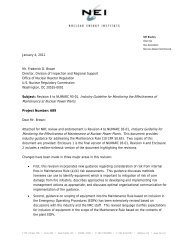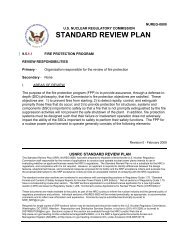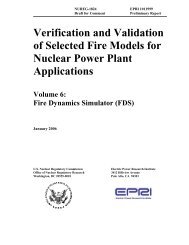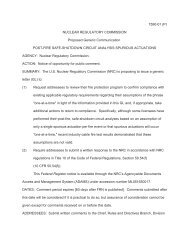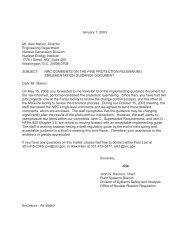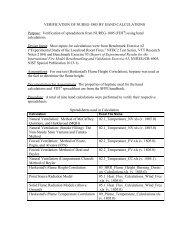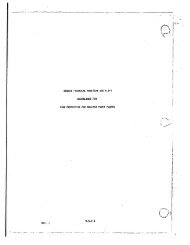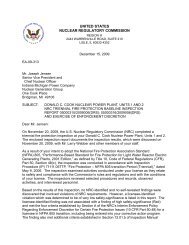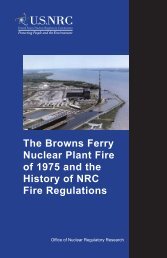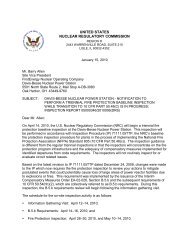NUREG/CR-6850, Volume 1 - NRC
NUREG/CR-6850, Volume 1 - NRC
NUREG/CR-6850, Volume 1 - NRC
You also want an ePaper? Increase the reach of your titles
YUMPU automatically turns print PDFs into web optimized ePapers that Google loves.
Conclusions and Closing RemarksThe predominant root source for current estimates of spurious actuation likelihood is testingperformed by NEI and EPRI in cooperation with <strong>NRC</strong> [3.3, 3.4, 3.5]. In particular, the valuescited in Task 10 are those recommended by an EPRI-convened expert panel [3.4], with limitedsupplemental insights derived from the subsequent EPRI full data analysis report [3.3].Insights gained through the demonstration studies, the peer review process, and the publiccomment process have highlighted mismatches between the needs of a Fire PRA and the currentestimates of spurious actuation probability. In general, the consensus of the EPRI and RESTechnical Development Teams is that when all relevant factors associated with the Fire PRAapplication are taken into consideration, the cited spurious actuation probability values aregenerally conservative. The degree of conservatism will clearly vary depending on the specificcase circumstances and in all cases remains unproven. Our judgment in this regard includesconsideration of several interacting factors associated with the cable physical behaviors, fireexposure, circuit configuration, and failure modes considered in the Fire PRA.For the purposes of illustration, the following discussion focuses on internal or intra-cableshorting behavior in multi-conductor cables to the exclusion of external or inter-cable shortingbehaviors. Inter-cable shorting behaviors would face similar considerations.The input data provided to the EPRI expert panel focused on the likelihood that either oftwo specific target conductors experienced a hot short from either of two energized sourceconductors for the surrogate motor operated valve (MOV) control circuit tested. A Fire PRA istypically interested in a somewhat different question. For example, given a MOV where thedesired position is “open”, the risk-relevant question would be “what is the likelihood that thevalve spuriously closes?” In the context of the experiments, this would correspond to a hot shortenergizing the one target conductor representing the “close” side of the surrogate MOV controlcircuit. While the probability of a valve going closed is likely lower than the spurious actuationprobability promulgated by the expert panel, one cannot simply divide the expert panel value bytwo. That is, one cannot assume that a hot short impacting the “close” target conductor is half thelikelihood of impacting either the “open” or “close” target conductors. In many of the tests, ifone target conductor experienced a hot short then both target conductors experienced hot shorts.This implies a dependency that would not be properly quantified by a simple “divide by two”solution.Now consider a case cited during the peer review process. The cited case involved a specificcircuit configuration on a normally open MOV. Circuit analysis found that if the “open”conductor experienced a hot short first, then permanent valve damage could occur because thefault would bypass the valve limit switches, over-driving the valve into its “open” seats. In thiscase, the valve would remain open until repaired. However, if the valve experienced a hot shorton the “close” conductor first, the valve would close with no valve damage because the limitswitches remain effective for this fault configuration. For this example, the questions of hot shorttiming, and potentially duration, come into play. These subtleties are not currently captured bythe methods recommended in Tasks 9 and 10.As a final illustrative example, consider a case involving a normally closed high/low-pressureinterface MOV. Depending on the overall piping configuration and likely given other concurrent3-8





